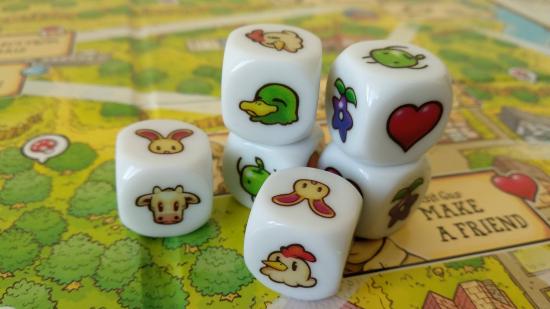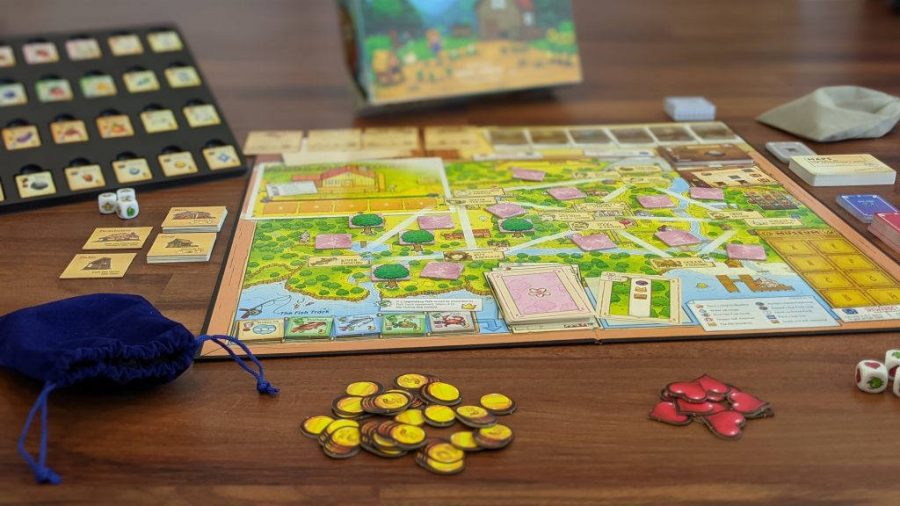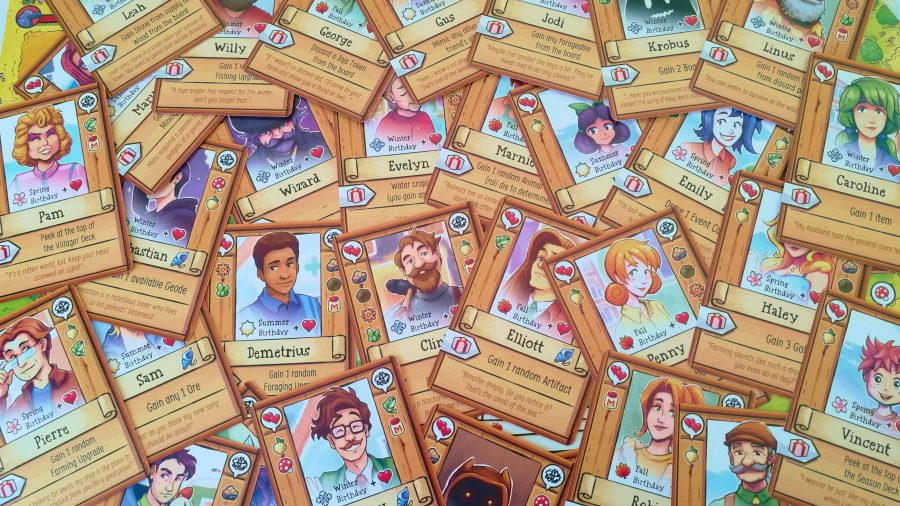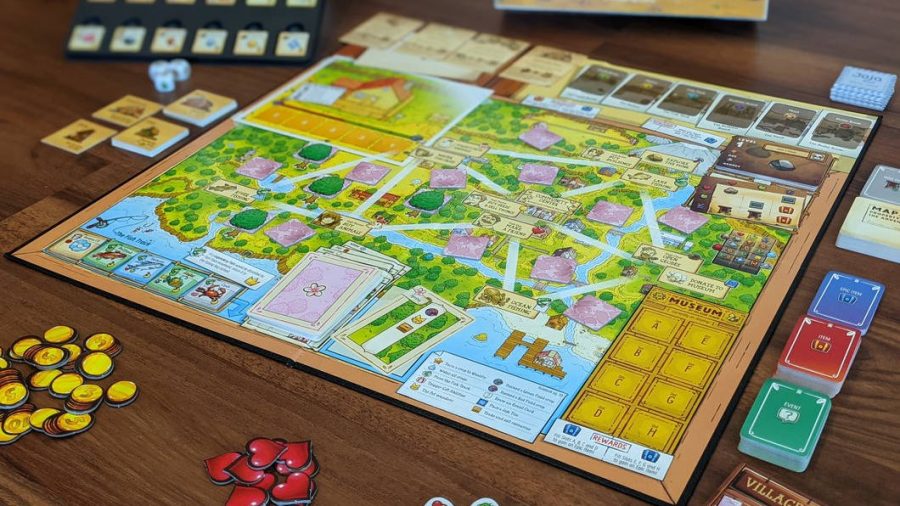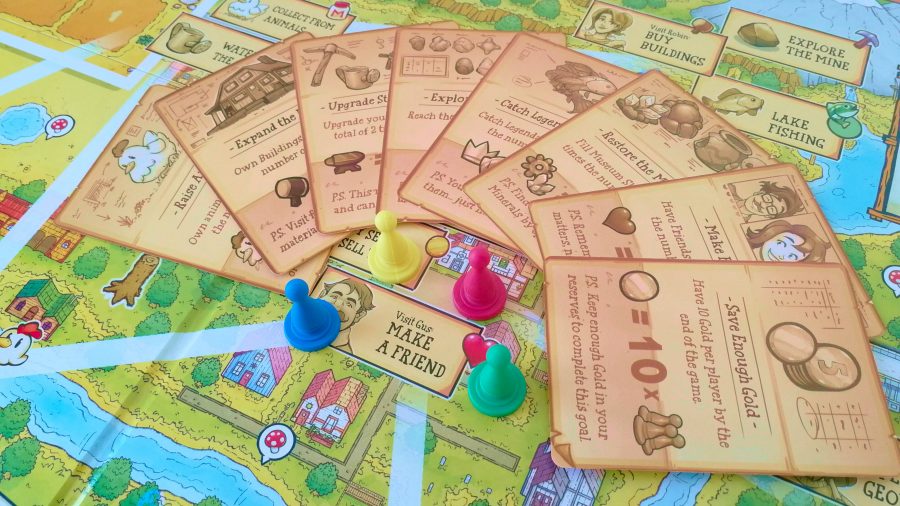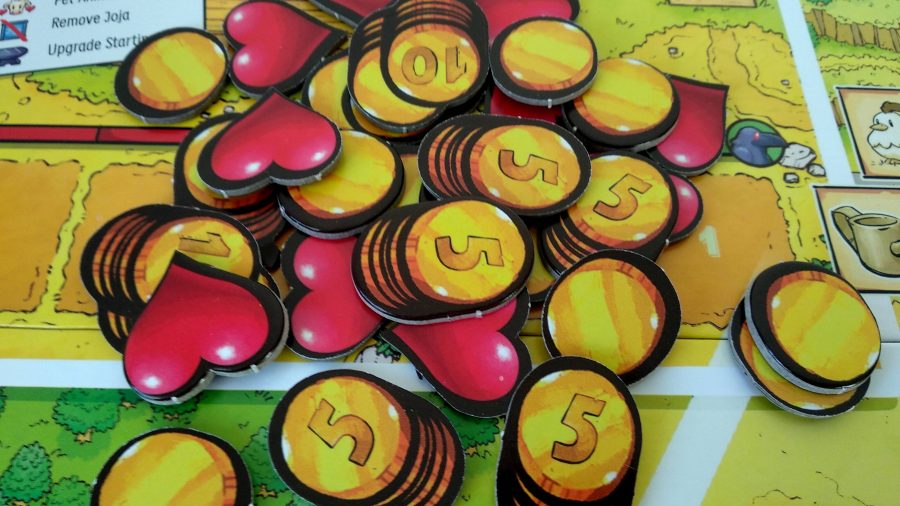Few videogames come close to the carefree innocence of Stardew Valley. Rejecting bustling city life in favour of peaceful rural paradise, it serves up a cheery, free-flowing adventure. Fish in the morning, tend to cattle in the evening, and spend the afternoon harvesting your beaming crops, or finding yourself a new best friend. Wholesome, friendly, charming: all appropriate descriptions of the leisurely game.
It’s a surprise, then, that Stardew Valley: The Board Game is a more hard-nosed experience. The familiar Pelican Town is there, with all the same locations, and exuberant locals, ever approachable, and always full of smiles. The game will have you doing all the same bizarre, and innocently absurd, activities of the videogame, presented in endearing, cartoonish visuals.
But this isn’t a board game of breezy adventure. Rather, it’s one of tough, co-operative turn optimisation. Across its one-and-a-half-hour playtime, you and up to three others will be shrewdly discussing your actions, managing your inventory, and desperately attempting to cope with the unpredictable obstacles that the game throws your way. There’s no such thing as carefree fun in this board game. Everything must be done with purpose, and no turn can go to waste. It’s persistently intense, and remarkably unforgiving.
Players take the role of a new farmhand, doing all the same activities they’d be doing in the videogame: buying seeds, planting and harvesting crops, fishing, exploring the nearby mine for stone and geodes, tending to animals, donating to the village museum, foraging for minerals, and buddying up with villagers to make new friends.
Wholly co-operative, players decide in tandem what to do each round, discussing what their aims for the turn should be, before placing their counters on a location, and activating its actions one at a time.
Some actions require players to roll dice, such as when exploring the mine or going fishing, to determine what resource they’ll receive from their efforts, if any at all. Others automatically succeed, such as watering crops, which shifts every seed on the planting queue one space, ready for harvesting. Any items you acquire will fall into your inventory, where they’ll be available to sell for gold, use in construction, contribute elsewhere, or be traded with another player, should your (pretty small) inventory become full.
And you’ll be spending most of your time deliberating on which resources to acquire, and what to do with them once they’re in your pockets. Sell a resource at Pierre’s general store for gold, and you can buy some more seeds, to accrue even more resources. Or perhaps you’d like to spend your newly acquired gold on a new farm building? Maybe your resources are better spent on making friends, and earning delicious heart tokens. Or you might think it best to save your resources, and use them later to complete an objective.
On any single turn, you’re presented with a slew of potential actions and decisions. But it’s not the scope of your capabilities that make play so frenetic, rather the game’s objectives. In a far cry from the videogame’s gentle gameplay, in which you can amble through its bucolic paradise with all the listlessness suitable for a fine summer’s day, the board game gives you ten defined objectives to race towards.
Four ‘Grandpa Goal’ cards will have you expand the farm, or help the community, while the six ‘Community Centre Objectives’ require you to gather specific resources, and restore the hub of the village back to its former glory.
Cream of the crop: Our pick of the best board games
But it’s a little more intense than first appearances might suggest. For starters, none of the Community Centre objectives are revealed at the beginning of the game. They loom as hidden tasks at the top of the game board, taunting you every turn that you don’t reveal them.
To do so, you’ll need ‘hearts’, acquired by making friends with the villagers, who, being typical country folk, will only show their affection if you provide them with gifts of milk, ore, fish, or whatever other strange resources you’ve acquired through your actions. Provide them with something they like, and you’ll get a bonus heart for your trouble. But give them an item they detest, and they’ll swat away your attempt at friendship.
Upon revealing the objectives, you’ll then need to complete them, providing sufficient resources of the correct variety. And, in the meantime, you should be working your way towards the goals that jolly ol’ Grandpa set for you, using up more resources in the process.
And the kicker: you only have 16 turns to complete them all. The game is broken into four seasons, with four cards representing each, stacked in a ‘seasons deck’. At the start of each turn, you’ll draw a season card, and carry out its random events. Once you reach the deck’s end, it’s game over, and you better hope you’ve completed every single thing that was asked of you.
The time limit is harsh, and it’ll constantly be weighing on your mind. Managing your resource spending, and choosing which actions to take in order to unlock, and complete, all objectives, in only 16 turns, is a tall order. Throw in the randomness of the season deck – which might offer a saving grace in the form of free crop-watering, or a free fish, or could completely scupper your plans by ravaging your crops with crows, or placing a pernicious Joja tile to inhibit your actions – and there’s precious little room for error.
Far from the languorous, carefree adventure of the videogame, Stardew Valley: The Board Game is all about results. And you can be damn sure that it will be hard to get them.
Where the game starts to fall flat, though, isn’t in its difficulty, but its unpredictability. On some turns, I was able to do everything right. My teammate befriended a villager with the correct item, before watering our crops – while I descended into the mine, and came up with some useful stone to show for it, foraging a valuable root vegetable, too, on my travels. We’d collected resources that could be used on later turns, and created a plan for tackling each objective.
Alone time: Check out the best solo board games
But rounds can quickly sour. Key dice rolls might not go your way, or you might turn over a particularly impertinent, ungrateful villager that has no interest in the mineral you’ve just dug up from the ground. The season card might destroy that tasty eggplant you were about to harvest next turn.
Dependency on chance is no bad thing, but, in this case, it really doesn’t feel commensurate with the potential difficulty of the game – which, oddly, is itself heavily determined by chance.
At the start of the game, the Grandpa Goals and Community Centre Objectives are chosen randomly. Each game, you have to hope you’ve been dealt some favourable ones, or your fate will quickly be sealed.
Goals such as building two farm buildings are not only easy, but useful, as they’ll multiply your resource-gathering throughout the game. Similarly, I wondered what challenge the goal of ‘making a number of friends three times the number of players’ really set, since I’d have to be doing that anyway, to unlock the Community Centre Objectives necessary to win. But others tell a very different story.
Exploring the mine to its bottom floor (level 12), or filling all the museum slots (again, doing so twice for each of the number of players in-game) are serious challenges that you might never come close to finishing by the game’s end. Even ‘catching a number of legendary fish equal to the number of players’ might sound like a surefire win, until you realise there’s only four such fish in the entire game, and you have to wait for them to appear. If you’re particularly unlucky when drawing from the ‘fish bag’, there’s no guarantee they’ll turn up at all.
These objectives’ mismatched difficulty feels all the more irritating for their mismatched enjoyability. Ordered to reach the bottom of the mine, my whole winter was spent traversing its tunnels. Turn after turn, I rolled the same two dice, and, despite some good luck on my side, still failed to get to its end. If nothing else, it served as a thoroughly anti-climactic, and frustrating end to the game, in which my efforts to think long and hard about every action, every detail, were swiftly thwarted by the game’s elements of chance.
Lining up the edges: Check out the best tile games
This is made all the worse because certain equippable boons that should make your playthrough much easier, and have you well on your way to victory, can often prove completely useless in your situation. The game has a habit of tripping over itself, unable to know what’s useful to you, or suitable for your objectives.
Earn an ‘epic item’ and you might be rewarded with the brilliant Deluxe Scarecrow, which will prevent crows from eating your plants, and instead water all of your seeds whenever the pesky birds come around. Compare that to the Copper Pan, which simply grants you one ore or geode whenever you fish, and the wild differences in items’ usefulness and relevance quickly appears. You might have little need for ore or geodes at that stage of the game, and, if you weren’t dealt the objective cards that tasked you with filling the museum’s display cases with geodes, that Copper Pan will be all but useless to you.
It’s a slap in the face when you carefully calculate your moves, and spend much time rigorously weighing up your available options, only for the game to hand you a series of cards that bear no relation to your current situation. It feels disjointed, with the game’s unpredictability serving more to excitedly highlight its own scope, than to generate satisfying gameplay.
If there’s one stand-out positive feature of Stardew Valley: The Board Game, it’s undoubtedly replayability. With a different combination of objectives, season cards, farm buildings, and villagers encountered in each game, plus thick item and event decks that you’ll barely make a dent in during any single run, you can play this board game over and over again. Each time, you’ll encounter new dilemmas and situations.
Most of my enjoyment of the game stemmed from this (typically Stardew Valley-esque) feeling of exploration. Discovering all the cards, meeting every villager, and seeing what new array of helpful and disruptive events the seasons would bring was a joy. I wanted to languidly pass through the game, playing to win, but not feeling as if my efforts were being unduly disrupted as I did so.
Littluns: Our guide to the best kids’ board games
And, in most instances, you’ll be able to identify your chance of victory fairly early on. Did you draw the obviously more challenging objective cards? Have you had a series of poor dice rolls? Did you get unlucky with your Season Cards in the first few rounds of play? If so, there’s little reason to continue playing, other than making the most of the raft of cards and tokens you’ve spent 20 minutes setting up.
Somewhere within Stardew Valley: The Board Game lies a fantastically cerebral, cooperative challenge. It tests your mettle, and offers new obstacles at every turn. But it can’t quite substantiate these obstacles, leaning towards sporadic disruption over directed, measured challenges. This isn’t a game for casual players, and certainly not one for those looking to bring the magic of the Stardew Valley videogame to the tabletop. It’s for those who like optimisation, and possess a thick skin against irritation.
